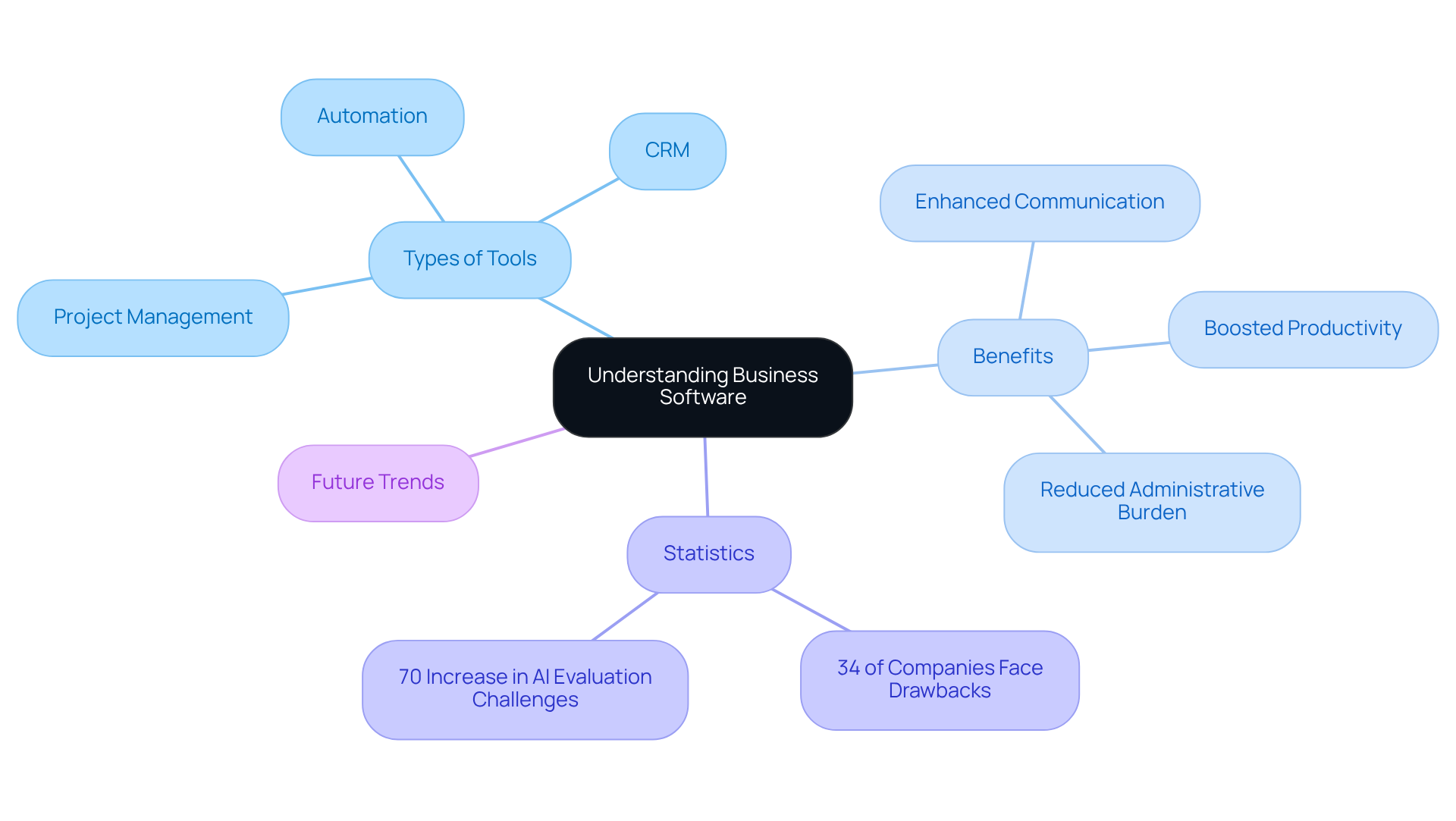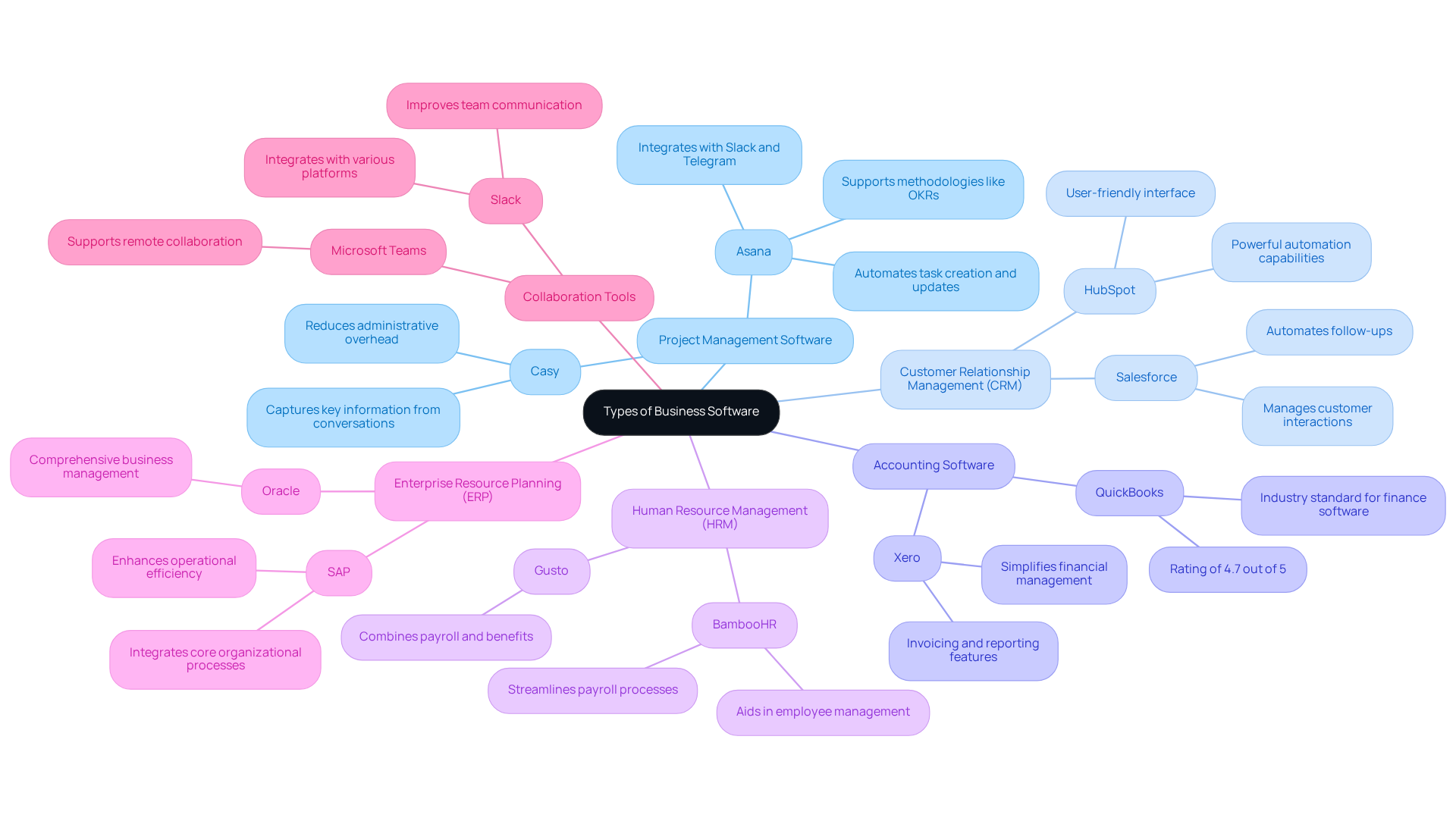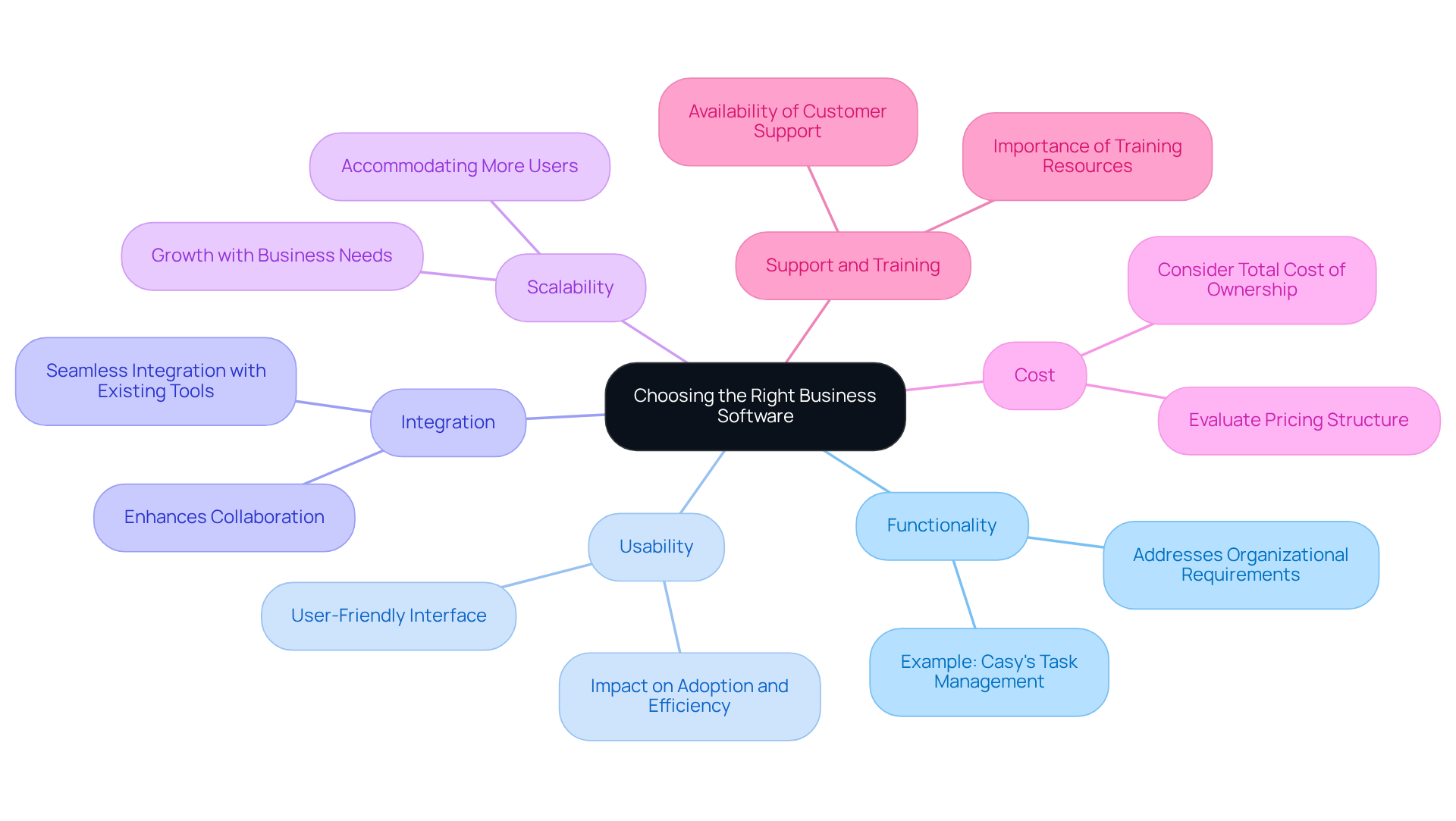Overview
This article examines the leading software options for businesses, specifically highlighting their key features and providing comparisons among top contenders such as Casy, Asana, and Trello. Effective business software is essential for enhancing productivity through automation, usability, and integration. Notably, Casy excels with its robust automation capabilities, tailored specifically for startups and agile teams.
Have you considered how your chosen software aligns with your organizational needs and future growth? Selecting the right tools is crucial for navigating the unique challenges faced by startup founders. Casy's features not only support immediate operational demands but also position your business for sustainable development.
In conclusion, understanding the strengths of various software options is vital for making informed decisions. By prioritizing solutions that foster productivity and adaptability, you can ensure that your business is equipped to thrive in a competitive landscape.
Introduction
In an increasingly competitive landscape, businesses are turning to innovative software solutions to streamline operations and enhance productivity. The right tools can automate tedious tasks, improve communication, and ultimately drive growth. Therefore, the selection of business software becomes a critical decision for any organization.
However, with a multitude of options available, how can companies effectively navigate the complexities of choosing the best software tailored to their unique needs?
This article delves into the top business software solutions, comparing their key features and benefits while addressing the challenges organizations face in making informed choices.
Understanding Business Software: Definition and Importance
Commercial applications encompass a diverse array of tools designed to optimize various operational functions, including project management and customer relationship management (CRM). These tools are essential for automating processes, enhancing communication, and boosting productivity. In today’s fast-paced business environment, the top software for business can significantly minimize manual tasks, streamline workflows, and enable teams to focus on their core activities. For instance, Casy automates task management by seamlessly capturing key information from conversations, significantly reducing administrative burdens and enhancing overall productivity. This level of automation is particularly crucial for startups and agile teams that require efficiency and adaptability in their operations.
Statistics reveal that organizations utilizing automation experience a notable rise in job satisfaction and innovation. In fact, 34% of companies report that poor technology selections have led to competitive drawbacks. As we approach 2025, the demand for such innovative solutions is expected to surge, with projections indicating five times the historical rate of new small enterprises, as noted by Elizabeth Gore, co-founder of Hello Alice. This trend underscores the growing recognition of the importance of top software for business in facilitating operational success.
Moreover, the number of purchasers struggling to evaluate the worth and risk of generative AI tools has increased by 70% year-over-year. This statistic emphasizes the challenges faced by startups in assessing application choices. Are you prepared to navigate these complexities? Understanding the value of tools like Casy could be the key to unlocking your startup's potential.

Exploring Different Types of Business Software
Business software can be categorized into several essential types, each serving distinct functions that cater to specific business needs:
-
Project Management Software: Tools such as Asana are vital for teams striving to plan, execute, and monitor projects effectively. This platform stands out for its ability to automate task creation and updates by integrating seamlessly with chat platforms like Slack and Telegram. Such integration significantly reduces administrative overhead while enhancing productivity. Additionally, methodologies like OKRs and the Eisenhower Matrix assist teams in prioritizing tasks efficiently. Businesses leveraging AI-powered automation save time, accelerate processes, and minimize human error. Consequently, tools like Casy are increasingly relevant in modern work environments, especially as 74% of U.S. companies are adopting or planning to implement hybrid work models by 2025.
-
Customer Relationship Management (CRM): Solutions such as Salesforce and HubSpot are crucial for managing customer interactions and data throughout the customer lifecycle. These platforms streamline communication and provide valuable insights into customer behavior, driving growth and improving retention.
-
Accounting Software: Programs like QuickBooks and Xero simplify financial management, invoicing, and reporting. QuickBooks, recognized as the industry standard, boasts a rating of 4.7 out of 5, underscoring its effectiveness in automating everyday financial tasks.
-
Human Resource Management (HRM): Software such as BambooHR and Gusto aids in employee management, payroll, and recruitment processes, ensuring organizations can efficiently address their workforce needs.
-
Enterprise Resource Planning (ERP): Comprehensive systems like SAP and Oracle integrate core organizational processes across departments, providing a unified platform that enhances operational efficiency.
-
Collaboration Tools: Platforms like Slack and Microsoft Teams improve group communication and cooperation, which are vital for sustaining productivity in remote and hybrid work settings.
Understanding these categories is essential for companies aiming to select the top software for business that aligns with their operational objectives and addresses specific challenges. As the market for project management applications continues to evolve, tools like Casy are becoming increasingly relevant, particularly for startups and fast-moving teams seeking to minimize operational overhead while maximizing efficiency.

Criteria for Choosing the Right Business Software
When selecting business software, it is essential to consider several key criteria to ensure the solution aligns with your startup's needs:
-
Functionality: The software must address specific organizational requirements, such as automating tasks or tracking project progress. Ensuring that any potential solutions meet your current and future business requirements is crucial to avoid ineffective solutions. For instance, Casy excels in transforming chat discussions into actionable tasks, streamlining project management for teams.
-
Usability: A user-friendly interface is crucial, as applications that are difficult to navigate can lead to poor adoption and inefficiencies. Research indicates that deep satisfaction in application usage is driven by usability and quality features, which are vital for maintaining productivity. This statistic highlights the significance of prioritizing usability in application selection.
-
Integration: Ensure the software can seamlessly integrate with existing tools and systems. This capability is vital for streamlining workflows and enhancing collaboration across teams. The importance of seamless integration cannot be overstated, especially for startups looking to enhance operational efficiency.
-
Scalability: The chosen solution should be able to grow alongside your business, accommodating an increasing number of users or additional features as needed. This adaptability is particularly important for startups anticipating rapid growth.
-
Cost: Evaluate the pricing structure to ensure it fits within your budget while delivering value. Hidden costs can accumulate quickly, so a clear understanding of total ownership costs is essential. Organizations should consider the total cost of ownership (TCO) when choosing applications, which includes licensing fees, user fees, and support costs.
-
Support and Training: Consider the availability of customer support and training resources. A robust support ecosystem can significantly enhance the implementation experience and help users maximize the program's potential. The degree of assistance provided by application vendors plays a crucial role in the selection process, as internal IT teams may not be able to address all issues.
By thoroughly evaluating these criteria, startups can select the top software for business that not only fulfills their immediate requirements but also promotes long-term growth and operational efficiency.

Comparative Analysis of Leading Business Software Solutions
In this comparative analysis, we examine three leading options that represent the top software for business: Casy, Asana, and Trello.
- Feature:
- Task Automation:
- Casy: Yes, captures tasks from chats (42% of tasks expected to be automated by 2027)
- Asana: Limited automation
- Trello: Manual task creation
- Integration:
- Casy: Slack, Telegram, and more
- Asana: Wide range of integrations
- Trello: Power-Ups for integrations
- User Interface:
- Casy: Minimalistic and intuitive
- Asana: User-friendly with multiple views
- Trello: Simple card-based layout
- Pricing:
- Casy: Competitive pricing
- Asana: Free tier available, premium options
- Trello: Free tier available, premium options
- Target Audience:
- Casy: Startups, game developers, product teams, and marketing professionals
- Asana: General project teams
- Trello: Small teams and personal projects
- Task Automation:
Casy distinguishes itself with robust automation capabilities, enabling teams to concentrate on their core activities without the hassle of manual updates. Asana offers a thorough project management framework with extensive integrations, making it ideal for larger groups. In contrast, Trello's straightforward card-based system is ideal for smaller teams or personal projects, though it lacks the automation features that another tool provides.
Additionally, Casy's commitment to data privacy with end-to-end encryption and strict visibility controls enhances its appeal, particularly for users concerned about security. This analysis underscores the unique strengths of each solution, guiding businesses in selecting the top software for business that is tailored to their specific needs. Are you ready to elevate your team's productivity with the right software?

Conclusion
The exploration of business software highlights its essential role in enhancing organizational efficiency and productivity. By integrating advanced tools into daily operations, businesses can automate processes, streamline workflows, and concentrate on their core objectives. Selecting the right software can be transformative, especially for startups and agile teams striving to adapt in a rapidly evolving market.
Key arguments emphasize the diverse categories of business software, encompassing:
- Project management
- CRM
- Accounting
- Collaboration tools
Each type serves a specific function, addressing unique business needs and challenges. Moreover, a comparative analysis of leading solutions like Casy, Asana, and Trello reveals the varying strengths and features that can significantly influence a team's productivity and operational success. Understanding factors such as functionality, usability, integration, scalability, cost, and support is crucial for making informed decisions when selecting the best software for business.
Ultimately, the importance of choosing the right business software cannot be overstated. As the demand for innovative solutions continues to grow, organizations must prioritize tools that align with their strategic goals and operational requirements. Embracing the right software not only drives efficiency but also cultivates a culture of innovation and adaptability, empowering businesses to thrive amidst future challenges.
Frequently Asked Questions
What are commercial applications in business software?
Commercial applications are tools designed to optimize various operational functions such as project management and customer relationship management (CRM). They are essential for automating processes, enhancing communication, and boosting productivity.
How do business software tools improve efficiency?
Business software tools minimize manual tasks, streamline workflows, and enable teams to focus on their core activities, thereby enhancing overall productivity.
What is an example of a business software tool mentioned in the article?
An example mentioned is Casy, which automates task management by capturing key information from conversations, reducing administrative burdens.
Why is automation important for startups and agile teams?
Automation is crucial for startups and agile teams as it promotes efficiency and adaptability in their operations, allowing them to respond quickly to changing needs.
What impact does automation have on job satisfaction and innovation?
Organizations utilizing automation experience a notable rise in job satisfaction and innovation, with statistics showing that 34% of companies report competitive drawbacks due to poor technology selections.
What is the forecast for the demand for innovative business software solutions by 2025?
The demand for innovative solutions is expected to surge, with projections indicating five times the historical rate of new small enterprises.
What challenges do purchasers face when evaluating generative AI tools?
The number of purchasers struggling to assess the worth and risk of generative AI tools has increased by 70% year-over-year, highlighting the difficulties startups face in making application choices.
How can understanding tools like Casy benefit startups?
Understanding the value of tools like Casy could be key to unlocking a startup's potential by enhancing efficiency and productivity.




